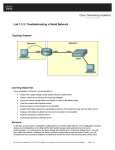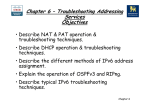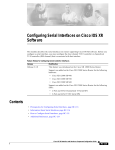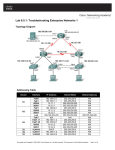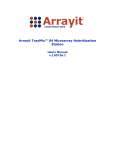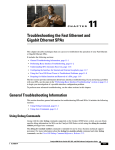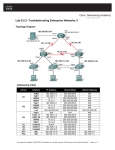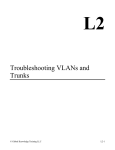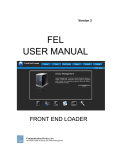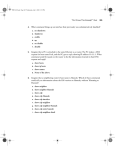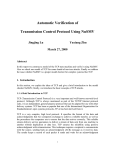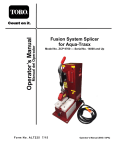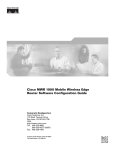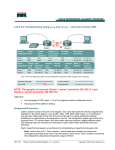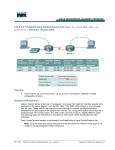Download Chapter 9 – Troubleshooting Converged Networks Objectives
Transcript
Chapter 9 – Troubleshooting Converged
Networks
Objectives
• Describe AAA operation & troubleshooting
techniques.
• Describe the operation and configuration of classic
and zone-based firewalls.
• Describe firewall troubleshooting techniques.
• Describe the operation and configuration of VPNs.
• Describe VPN troubleshooting techniques.
Chapter 9
Security Implementation
• The implementation of security features can affect
router and switch operation on different planes:
• Management Plane: Securing this plane is vital to the
overall security of the device, as it allows access to
device configuration via console, HTTP and VTY.
• Control Plane: represents all the functions and protocols
that are used between network devices to control the
operation of the network - such as routing protocols &
STP.
• Data Plane: Routers and switches can inspect and filter
traffic as part of the implementation of a security policy.
Chapter 9
Management Plane Security
• Telnet transmissions contain unencrypted data (including
the password), while SSH uses encryption to secure its
transmission.
• The CLI can always be accessed through the serial
console of the device. Authentication can limit access, but
anyone with the ability to power cycle the device can
perform the password recovery procedure and gain
control of the device.
• Cisco Configuration Professional (CCP) or the Security
Device Manager (SDM) can use either HTTP or HTTPS.
Chapter 9
The Three Components of AAA
• Authentication - Provides the method of identifying users, including
login and password dialog, challenge and response, messaging
support, and, depending on the security protocol selected,
encryption . RADIUS combines authentication and authorisation,
whereas TACACS+ decouples them.
• Authorisation - Provides the method for remote access control,
including one-time authorisation or authorisation for each service.
RADIUS does not allow specification (or enforcement) of which
commands can be and which commands cannot be executed on a
router, whereas TACAC+ does.
• Accounting - Provides the method for collecting and sending
security server information used for billing, auditing, and reporting.
RADIUS has extensive accounting capabilities, while TACACS+ has
limited accounting capabilities.
Chapter 9
Configuring AAA Authentication
R1
AAA Server –
192.168.229.76
Configure TACAS+
R1(config)#aaa new-model
R1(config)#tacacs-server host 192.168.229.76 single-connection
R1(config)#tacacs-server key ciscosecret
Configure RADIUS
R1(config)#aaa new-model
R1(config)#radius-server host 192.168.229.76 auth-port 1812
R1(config)#radius-server key ciscosecret
The authentication login command in global configuration mode enables the AAA
authentication process:
1st 2nd 3rd
R1(config)#aaa authentication login default group radius local line
R1(config)#aaa authentication login TELNET_LINES group radius
R1(config)#line console 0
R1(config-line)#login authentication default
R1(config-line)#line vty 0 4
R1(config-line)#login authentication TELNET_LINES
R1#debug aaa authentication
Chapter 9
‘AAA Authorization’ Commands
R1
AAA Server –
192.168.229.76
R1(config)#aaa authorization exec default group radius local none
R1(config)#aaa authorization exec default group tacacs+ local none
R1#debug aaa authorization
R1#debug radius
R1#debug tacacs+
Chapter 9
Configuring Local AAA
Authentication/Authorisation
R1
AAA Server –
192.168.229.76
R1(config)#username admin privilege 15 secret cisco
R1(config)#enable secret class
R1(config)#aaa new-model
R1(config)#aaa authentication login default local
R1(config) #aaa authorization exec default local
R1(config)#line console 0
R1(config-line)#login local
•Authenticated user will still need to enter the ‘enable
secret’ password to access privileged exec mode
Chapter 9
AAA Accounting Commands
R1
AAA Server –
192.168.229.76
R1(config)#aaa accounting exec default start-stop group radius
R1(config)#aaa accounting exec default stop-only group tacacs+
Only logs when an operation is completed – generates less information than
the start-stop command
R1#debug aaa accounting
Chapter 9
Troubleshooting the Management
Plane
• From a troubleshooting standpoint, it is very important to
know the answer to the following questions:
1. What security policies have been implemented for
management access to the devices?
2. From which IP addresses or networks can the network
devices be accessed?
3. What type of authentication, authorization, and
accounting is used on the network?
4. If centralized AAA services are deployed, what happens
when these servers fail or become unreachable?
5. Are there any backdoors or fallback mechanisms to
access the devices?
Chapter 9
Troubleshooting the Management Plane
R1#debug aaa authentication
*Mar 3 14:39:39.435: AAA/BIND(0000000E): Bind i/f
*Mar 3 14:39:39.435: AAA/AUTHEN/LOGIN (0000000E): Pick method list ‘ADMIN’
*Mar 3 14:39:59.211: AAA: parse name=tty66 idb type=-1 tty=-1
*Mar 3 14:39:59.211: AAA: name=tty66 flags=0x11 type=5 shelf=0 slot=0 adapter=0
port=66 channel=0
*Mar 3 14:39:59.211: AAA/MEMORY: create_user (0x83C938B4) user=’kevin’
ruser=’NULL’ ds0=0 port=’tty66’ rem_addr=’192.168.1.50’ authen_type=ASCII
service=ENABLE priv=15 initial_task_id=’0’, vrf= (id=0)
*Mar 3 14:39:59.211: AAA/AUTHEN/START (4286245615): port=’tty66’ list=’’
action=LOGIN service=ENABLE
*Mar 3 14:39:59.211: AAA/AUTHEN/START (4286245615): non-console enable - default
to enable password
*Mar 3 14:39:59.215: AAA/AUTHEN/START (4286245615): Method=ENABLE
*Mar 3 14:39:59.215: AAA/AUTHEN(4286245615): Status=GETPASS
*Mar 3 14:40:00.710: AAA/AUTHEN/CONT (4286245615): continue_login
(user=’(undef)’)
*Mar 3 14:40:00.710: AAA/AUTHEN(4286245615): Status=GETPASS
*Mar 3 14:40:00.710: AAA/AUTHEN/CONT (4286245615): Method=ENABLE
*Mar 3 14:40:00.770: AAA/AUTHEN(4286245615): Status=PASS
*Mar 3 14:40:00.770: AAA/MEMORY: free_user (0x83C938B4) user=’NULL’ ruser=’NULL’
port=’tty66’ rem_addr=’192.168.1.50’ authen_type=ASCII service=ENABLE priv=15 vrf= (id=0)
Chapter 9
Troubleshooting the Control Plane
• A check-list similar to the following could be used by
support engineers to troubleshoot control plane security
implementations:
1. Are routing protocols or first hop redundancy protocols
setup for authentication properly?
2. Are Spanning Tree Protocol security features such as
BPDU Guard, BDPU Filter, Loop Guard, or Root Guard
enabled correctly?
3. Is DHCP snooping configured properly?
4. Is the configuration of Dynamic ARP Inspection
correct?
5. Are the configurations for control plane policing or
control plane protection done appropriately?
Chapter 9
DHCP Snooping - Configuration
Client-VLAN 10
ALS1 Untrusted
DLS1
Legitimate
DHCP
Server
Fa0/2
Trusted
Fa0/1
Fa0/1
Trunk - Trusted
Fa0/2
Fa0/3
Untrusted
•ALS1(config)#ip dhcp snooping
Rogue DHCP
•ALS1(config)#ip dhcp snooping vlan 10
Server
•ALS1(config)#interface Fa0/1
•ALS1(config-if-range)#ip dhcp snooping trust
•ALS1(config)#interface range fa0/2-3
•ALS1(config-if-range)#ip dhcp snooping limit rate 20
•ALS1(config-if-range)#ip verify source vlan dhcp-snooping port-security
•DLS1(config)#ip dhcp snooping
•DLS1(config)#ip dhcp snooping vlan 10
•DLS1(config)#interface range Fa0/1-2
•DLS1(config-if-range)#ip dhcp snooping trust
•DLS1(config)# ip dhcp relay information trust-all
Chapter 9
Dynamic ARP Inspection Configuration
Client-VLAN 10
ALS1 Untrusted
DLS1
Legitimate
DHCP
Server
Fa0/2
Trusted
Fa0/1
Fa0/2
Fa0/1
Trunk - Trusted
Fa0/3
Untrusted
•DLS1(config)#ip arp inspection vlan 10
•DLS1(config)#interface range Fa0/1-2
•DLS1(config-if-range)#ip arp inspection trust
•ALS1(config)#ip arp
•ALS1(config)#ip arp
•ALS1(config)#ip arp
•ALS1(config)#ip arp
Rogue DHCP
Server
inspection vlan 10
inspection validate src-mac
inspection validate dst-mac
inspection validate ip
•ALS1(config)#interface Fa0/1
•ALS1(config-if-range)#ip arp inspection trust
Chapter 9
Spanning Tree Protection
• Portfast – rapid transition to forwarding
state for access ports.
Root
•UDLD
•UDLD
• BPDU guard- protects portfast ports from
creating loops.
•UDLD
•UDLD
•Loopguard
•BPDU Filter – stops BPDUs being sent from
an interface.
•UDLD
•Rootguard
•UDLD
• Root Guard – controls which ports are
eligible to participate in root election.
•UDLD
•Loopguard
• Unidirectional Link Detection (UDLD) –
prevents links transitioning to forwarding
state under unidirectional fault conditions.
•Portfast
•BPDU Guard
•BPDU Filter
Blocking
• Loopguard – prevents links transitioning to
forwarding under unidirectional fault
conditions if designated port still operational.
Forwarding
Chapter 9
Securing the Data Plane
•The Cisco IOS Firewall
software provides enhanced
security functions for the data
plane.
•There are two types of Cisco
IOS Firewall:
1.
Classic Cisco IOS Firewall
(stateful packet inspection)
2. Zone-Based Policy Firewall
Chapter 9
Classic IOS Firewall Operation
1.
Create Inspection rule and ACL:
Firewall(config)#ip inspect name FW_RULE tcp
Firewall(config)#access-list 101 permit tcp any any eq 80
Inside
Fa0/0
10.0.0.3/24
Port 2447
R1
Firewall
Outside
Fa0/1
172.30.1.50/24
Port 80
2. Apply Inspection rule and ACL to inside interface:
Firewall(config)# int fa0/0
Firewall(config-if)#ip access-group 101 in
Firewall(config-if)#ip inspect FW_RULE in
4. Apply ACL to outside interface:
Firewall(config)# int fa0/1
Firewall(config-if)#ip access-group 102 in
3. Create outside ACL:
Firewall(config)#access-list 102 deny ip any any
Firewall(config)#access-list 102 permit tcp 172.30.1.50 eq 80 host 10.0.0.3 eq 2447
Firewall#Show ip inspect config | session | interfaces
Chapter 9
Verify Classic Firewall Operation
Inside
Fa0/0
10.0.0.3/24
Port 2447
R1
Firewall
Outside
Fa0/1
172.30.1.50/24
Port 80
Firewall#show ip inspect session
Established Sessions
Session 84638E80 (10.0.0.3:2447)=>(172.30.1.50:80) http SIS_OPEN
Firewall#show ip inspect session detail
Established Sessions
Session 84638E80 (192.168.1.50:2447)=>(172.30.1.50:80) http SIS_OPEN
Created 00:01:54, Last heard 00:01:32
Bytes sent (initiator:responder) [408:166394]
In SID 172.30.1.50[80:80]=>10.0.0.3[2447:2447] on ACL 102 (116 matches)
Chapter 9
Verify Classic Firewall Operation
Inside
Fa0/0
10.0.0.3/24
Port 2447
R1
Firewall
Outside
Fa0/1
172.30.1.50/24
Port 80
Firewall#show ip inspect all
Session audit trail is enabled
Session alert is enabled
one-minute (sampling period) thresholds are [unlimited : unlimited] connections
max-incomplete sessions thresholds are [unlimited : unlimited]
max-incomplete tcp connections per host is unlimited. Block-time 0 minute.
tcp synwait-time is 30 sec — tcp finwait-time is 5 sec
tcp idle-time is 3600 sec — udp idle-time is 30 sec
tcp reassembly queue length 16; timeout 5 sec; memory-limit 1024 kilo bytes
dns-timeout is 5 sec
Inspection Rule Configuration
Inspection name FW_RULE
http alert is on audit-trail is on timeout 3600
Interface Configuration
Interface FastEthernet0/0
Inbound inspection rule is FW_RULE
Outgoing inspection rule is not set
Chapter 9
Monitor Classic Firewall Operation
Inside
Fa0/0
10.0.0.3/24
Port 2447
R1
Firewall
Outside
Fa0/1
172.30.1.50/24
Port 80
•To see real-time updates about the sessions being monitored by a
router, enter the ip inspect audit-trail global configuration mode
command.
•This causes syslog messages to be created whenever a router
creates a new stateful inspection session.
Firewall(config)#ip inspect audit-trail
*Mar 3 12:46:32.465: %SYS-5-CONFIG_I: Configured from console by console
*Mar 3 12:47:10.115: %FW-6-SESS_AUDIT_TRAIL_START: Start http
session: initiator (10.0.0.3:2447) — responder (172.30.1.50:80)
Chapter 9
Zone Based Firewall Operation
PRIVATE
Fa0/0
PUBLIC
Fa0/1
R1
Firewall
172.30.1.50/24
10.0.0.3/24
Firewall(config)#class-map type inspect match-any PRIV_PUB_CLASS
Firewall(config-cmap)#match prot http
Firewall(config)#policy-map type inspect PRIV_PUB_POL
Firewall(config-pmap)#class type inspect PRIV_PUB_CLASS
Firewall(config-pmap-c)#inspect
Firewall(config)#zone security PRIVATE
Firewall(config)#zone security PUBLIC
Firewall(config)#zone-pair security PRIV_PUB source PRIVATE destination PUBLIC
Firewall(config-sec-zone-pair)#service-policy type inspect PRIV_PUB_POL
Firewall(config)#int fa0/0
Firewall(config-if)#zone-member security PRIVATE
Firewall(config-if)#int fa0/1
Firewall(config-if)#zone-member security PUBLIC
Chapter 9
Verify Zone Based Firewall
Operation
• There are several useful show commands for performing
Zone Based Policy Firewall troubleshooting and
verification:
• show zone security: displays information for all the zones configured on the
router and the corresponding member interfaces – allows verification of
zones configuration and their assignment.
• show zone-pair security: provides important information about how zones are
paired, the zone-pair direction (with respect to the traffic flow), and the
policy applied to the zone-pair traffic.
• show policy-map type inspect: shows the relevant information for the policy,
what traffic is matched to which class, and what action is applied to each
class of traffic.
Chapter 9
Firewall Exceptions
PRIVATE
Fa0/0
10.0.0.3/24
PUBLIC
Fa0/1
R1
Firewall
172.30.1.50/24
Firewall(config)# ip access-list extended INBOUND
Firewall(config-ext-nacl)#permit ahp host 172.30.1.50 host 10.0.0.3
Firewall(config-ext-nacl)#permit esp host 172.30.1.50 host 10.0.0.3
Firewall(config-ext-nacl)#permit gre host 172.30.1.50 host 10.0.0.3
Firewall(config-ext-nacl)#permit udp any any eq isakmp
Firewall(config-ext-nacl)#permit udp any any eq non500 isakmp
Firewall(config-ext-nacl)#permit icmp any any echo-reply
Firewall(config-ext-nacl)#permit icmp any any unreachable
Firewall(config-ext-nacl)#eigrp any any
Firewall(config)#int fa0/1
Firewall(config-if)#ip access-group INBOUND in
Chapter 9
VPN Topologies
Remote Access VPN
Site-to-Site Intranet
VPN
Chapter 9
Remote Office Issues
• VPN mis-configuration.
• Over-lapping IP address spaces.
• Dynamic routing protocols, sub-optimal
routing.
• MTU Size.
• Router processor overhead.
• User authentication.
• User software.
Chapter 9
IPsec Tunnel CLI Configuration
R1(config)#crypto map VPN 10 ipsec-isakmp
R1(config-crypto-map)#match address 101
R1(config-crypto-map)#set peer 192.168.23.3
R1(config-crypto-map)#set pfs group5
R1(config-crypto-map)#set transform-set 10
R1(config)#interface fa0/0
R1(config-if)#crypto-map VPN
R1(config)# crypto isakmp policy 10
R1(config-isakmp)#authentication pre-share
R1(config-isakmp)#encryption aes 256
R1(config-isakmp)#hash sha
R1(config-isakmp)#group 5
R1(config-isakmp)#lifetime 3600
R1(config)#crypto isakmp key cisco address 192.168.23.3
R1(config)# crypto ipsec transform-set 10
R1(cfg-crypto-trans)#esp-aes 256 esp-sha-hmac
R1(config)#crypto ipsec security-association lifetime seconds 1800
R1(config)#access-list 101 permit ip 172.16.1.0 0.0.0.255 172.16.3.0 0.0.0.255
Chapter 9
Secure GRE Tunnel CLI Configuration
Note - ISAKMP
policy,
IPsec transform
sets & crypto maps
must also be
configured
R1(config)#interface tunnel 0
R1(config-if)#ip address 172.16.13.1 255.255.255.0
R1(config-if)#tunnel source fa0/0
R1(config-if)#tunnel destination 192.168.23.3
R1(config)#access-list 101 permit gre host 192.168.12.1 host 192.168.23.3
Note that this ACL must be ‘mirrored’ on R3 to reflect the difference in
source and destination addresses.
Chapter 9
Verify VPN Service
• R1#show crypto ipsec sa
• R1#show crypto isakmp sa
• R1#show crypto session
• R1#show crypto map
• R1#debug crypto ipsec
R1#sh crypto isakmp sa
IPv4 Crypto ISAKMP SA
dst
src
state
conn-id
192.168.23.3 192.168.12.1 QM_IDLE 1002
slot status
0 ACTIVE
• R1#debug crypto isakmp
R1# show crypto map
Crypto Map “VPN" 10 ipsec-isakmp
Peer = 192.168.23.3
Extended IP access list 101
access-list 101 permit ip 172.16.1.0 0.0.0.255 172.16.3.0 0.0.0.255
Current peer: 192.168.23.3
Security association lifetime: 4608000 kilobytes/1800 seconds
PFS (Y/N): N
Transform sets={
10,
}
Interfaces using crypto map map1:
FastEthernet0/0
Chapter 9
VPN Troubleshooting Example
Lo0 - 10.100.100.1/24
10.1.1.1/24
Tunnel End-Points
S0/0/0
Fa0/0
Branch
S0/0/0
172.16.1.1/24
10.1.3.2/24
Lo0 - 10.200.200.2/24
192.168.1.2/24
GRE/IPSEC Tunnel
Fa0/0
HQ
10.2.2.1/24
10.1.3./24
•IPsec tunnel is established and tested, and it was carrying user traffic with no
problem. Then tunnel interface went down and EIGRP was no longer able to advertise
routes. Tunnels get established, only to go down after a few seconds every time.
BRANCH#show interface tunnel0
Tunnel0 is up, line protocol is down
Hardware is Tunnel
Internet address is 10.1.3.2 255.255.255.0
MTU 1514 bytes, BW 9 Kbit, DLY 500000 usec,
Reliability 255/255, txload 1/255, rxload 1/255
Encapsulation TUNNEL, loopback not set
Keepalive not set
Tunnel source 10.100.100.1 (Loopback101), destination 10.200.200.2
Tunnel protocol/transport GRE/IP
Key disabled, sequencing disabled
Checksumming of packets disabled
Chapter 9
VPN Troubleshooting Example
Lo0 - 10.100.100.1/24
10.1.1.1/24
Tunnel End-Points
S0/0/0
Fa0/0
Branch
S0/0/0
172.16.1.1/24
10.1.3.2/24
Lo0 - 10.200.200.2/24
192.168.1.2/24
GRE/IPSEC Tunnel
Fa0/0
HQ
10.2.2.1/24
10.1.3./24
HQ(config)#int tunnel0
HQ(config-if)#shutdown
HQ(config-if)#no shutdown
HQ(config-if)#end
HQ#
%SYS-5-CONFIG_I: Configured from console by console
HQ#
%DUAL-5-NBRCHANGE: IP-EIGRP(0) 1: Neighbor 10.1.3.2 (Tunnel0) is up: new adjacency
HQ#
%TUN-5-RECURDOWN: Tunnel0 temporarily disabled due to recursive routing
%LINEPROTO-5-UPDOWN: Line protocol on Interface Tunnel0, changed state to down
%DUAL-5-NBRCHANGE: IP-EIGRP(0) 1: Neighbor 10.1.3.2 (Tunnel0) is down: interface down
Chapter 9
VPN Troubleshooting Example
Lo0 - 10.100.100.1/24
10.1.1.1/24
Tunnel End-Points
S0/0/0
Fa0/0
Branch
S0/0/0
172.16.1.1/24
10.1.3.2/24
Lo0 - 10.200.200.2/24
192.168.1.2/24
GRE/IPSEC Tunnel
Fa0/0
HQ
10.2.2.1/24
10.1.3./24
HQ# show ip route
10.0.0.0 255.0.0.0 is variably subnetted, 8 subnets, 2 masks
C 10.1.3.0 255.255.255.0 is directly connected, Tunnel0
C 10.200.200.0 255.255.255.0 is directly connected, Loopback0
D 10.100.100.0 255.255.255.0 [90/297372416] via 10.1.3.2, 00:00:07, Tunnel0
C 10.2.2.0 255.255.255.0 is directly connected, FastEthernet0/0
D 10.1.1.0 255.255.255.0 [90/297372416] via 10.1.3.2, 00:00:07, Tunnel0
C 192.168.1.0 255.255.255.0 is directly connected, serial0/0/0
S* 0.0.0.0 0.0.0.0 [1/0] via 192.168.1.1
•Mis-configuration of routing over GRE tunnels can lead to recursive
routing. When the best path to the tunnel destination is through the
tunnel itself, recursive routing causes the tunnel interface to flap.
Chapter 9
VPN Troubleshooting Example
Lo0 - 10.100.100.1/24
10.1.1.1/24
Tunnel End-Points
Lo0 - 10.200.200.2/24
S0/0/0
Fa0/0
Branch
S0/0/0
172.16.1.1/24
10.1.3.2/24
192.168.1.2/24
GRE/IPSEC Tunnel
Fa0/0
HQ
10.2.2.1/24
10.1.3./24
HQ (config)#ip route 10.100.100.1 255.255.255.0 s0/0/0
HQ# show ip route
10.0.0.0 255.0.0.0 is variably subnetted, 8 subnets, 2 masks
C 10.1.3.0 255.255.255.0 is directly connected, Tunnel0
C 10.200.200.0 255.255.255.0 is directly connected, Loopback101
D 10.100.100.0 255.255.255.0 [90/297372416] via 10.1.3.2, 00:00:07, Tunnel0
C 10.2.2.0 255.255.255.0 is directly connected, FastEthernet0/0
D 10.1.1.0 255.255.255.0 [90/297372416] via 10.1.3.2, 00:00:07, Tunnel0
S 10.100.100.1 255.255.255.255 [1/0] via 172.16.1.1
C 192.168.1.0 255.255.255.0 is directly connected, serial0/0/0
S* 0.0.0.0 0.0.0.0 [1/0] via 192.168.1.1
•One way to fix this issue is to make sure that there is always a path to
the tunnel destination, and that path is better than the one through the
tunnel itself – use static routes.
Chapter 9
Chapter 9 – Troubleshooting Converged
Networks
Objectives
• Describe AAA operation & troubleshooting
techniques.
• Describe the operation and configuration of classic
and zone-based firewalls.
• Describe firewall troubleshooting techniques.
• Describe the operation and configuration of VPNs.
• Describe VPN troubleshooting techniques.
Chapter 9
Any
Questions?
Chapter 9

































